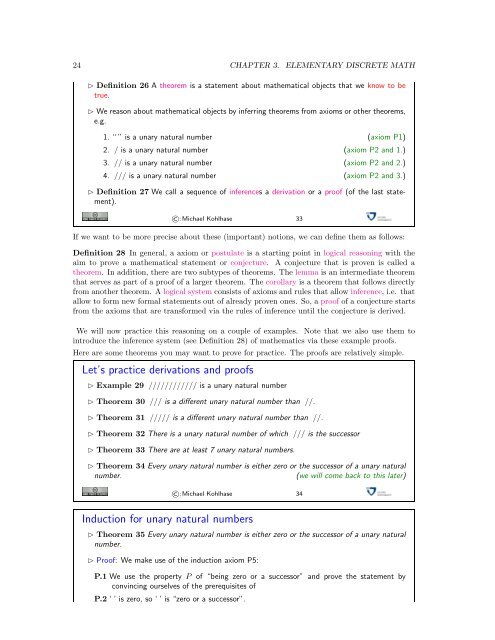General Computer Science 320201 GenCS I & II Lecture ... - Kwarc
General Computer Science 320201 GenCS I & II Lecture ... - Kwarc
General Computer Science 320201 GenCS I & II Lecture ... - Kwarc
Create successful ePaper yourself
Turn your PDF publications into a flip-book with our unique Google optimized e-Paper software.
24 CHAPTER 3. ELEMENTARY DISCRETE MATH<br />
Definition 26 A theorem is a statement about mathematical objects that we know to be<br />
true.<br />
We reason about mathematical objects by inferring theorems from axioms or other theorems,<br />
e.g.<br />
1. “ ” is a unary natural number (axiom P1)<br />
2. / is a unary natural number (axiom P2 and 1.)<br />
3. // is a unary natural number (axiom P2 and 2.)<br />
4. /// is a unary natural number (axiom P2 and 3.)<br />
Definition 27 We call a sequence of inferences a derivation or a proof (of the last statement).<br />
©: Michael Kohlhase 33<br />
If we want to be more precise about these (important) notions, we can define them as follows:<br />
Definition 28 In general, a axiom or postulate is a starting point in logical reasoning with the<br />
aim to prove a mathematical statement or conjecture. A conjecture that is proven is called a<br />
theorem. In addition, there are two subtypes of theorems. The lemma is an intermediate theorem<br />
that serves as part of a proof of a larger theorem. The corollary is a theorem that follows directly<br />
from another theorem. A logical system consists of axioms and rules that allow inference, i.e. that<br />
allow to form new formal statements out of already proven ones. So, a proof of a conjecture starts<br />
from the axioms that are transformed via the rules of inference until the conjecture is derived.<br />
We will now practice this reasoning on a couple of examples. Note that we also use them to<br />
introduce the inference system (see Definition 28) of mathematics via these example proofs.<br />
Here are some theorems you may want to prove for practice. The proofs are relatively simple.<br />
Let’s practice derivations and proofs<br />
Example 29 //////////// is a unary natural number<br />
Theorem 30 /// is a different unary natural number than //.<br />
Theorem 31 ///// is a different unary natural number than //.<br />
Theorem 32 There is a unary natural number of which /// is the successor<br />
Theorem 33 There are at least 7 unary natural numbers.<br />
Theorem 34 Every unary natural number is either zero or the successor of a unary natural<br />
number. (we will come back to this later)<br />
©: Michael Kohlhase 34<br />
Induction for unary natural numbers<br />
Theorem 35 Every unary natural number is either zero or the successor of a unary natural<br />
number.<br />
Proof: We make use of the induction axiom P5:<br />
P.1 We use the property P of “being zero or a successor” and prove the statement by<br />
convincing ourselves of the prerequisites of<br />
P.2 ‘ ’ is zero, so ‘ ’ is “zero or a successor”.
















